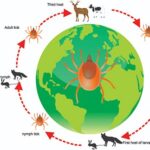Summer Tick Protection
- By Pia Hinckle
- Reading Time: 5 mins.
Everything you need to stay safe from ticks

Summer is prime time for hiking, camping, horseback riding, and exploring the beautiful outdoors. But even if you’re only in your backyard or walking your dog at a local park, you should know how to protect yourself from a tiny bug that is the number one disease vector in the United States: the tick.
Why worry? Ticks have been called nature’s dirty needles for their ability to harbor and spread various diseases, and the number of people getting sick from their bites has more than doubled in the last 13 years. Tick-borne diseases “accounted for more than 60 percent of all reported mosquito-borne, tick-borne, and flea-borne disease cases. Diseases from ticks vary from region to region across the U.S. and those regions are expanding,” according to a May 2018 press release from the Centers for Disease Control. And while spring, summer, and fall may provide peak exposure for people because of increased outdoor activity, ticks are present year-round in most areas, even in winter, according to the University of Rhode Island TickEncounter Resource Center.
While ticks are infamous for carrying Lyme disease, they also may harbor potentially life-threatening viruses, fungi, protozoa, and bacteria, including Babesia (a microscopic parasite that causes a malaria-like infection), Ehrlichia, Anaplasma, Bartonella, Rocky Mountain spotted fever, tularemia, and Powassan virus. It’s possible to become infected with multiple diseases from a single or a series of tick bites. Ticks aren’t born with these diseases but rather pick them up from animals they feed upon, including birds, rodents, and deer.
Symptoms of many tick-borne infections can initially appear mild, flu-like, and hard to distinguish from other illnesses. Most physicians aren’t trained to test for these infections as part of a general screening, so unfortunately detection is difficult and often delayed. Finding a Lyme-literate doctor is key to prompt diagnosis and treatment.
Prevention Is Key
Prevention is considered the single best way to keep yourself free of these life-changing and sometimes life-threatening diseases. According to Lymedisease.org, an advocacy group promoting awareness and treatment of tick-borne illnesses, you could become infected even if a tick is attached for less than 24 hours or whether or not you found a rash. The sooner you find and remove a tick the better your chances of avoiding infection. Many people never even know they were bitten, as tick bites are painless and don’t generally itch like mosquito or flea bites. In the tick’s nymphal stage, it’s as tiny as a pinhead and difficult to detect. Nymphs are suspected to be the main transmitters of Lyme disease.

Ticks are related to spiders and are found virtually everywhere in the U.S., preferring to hang out on grasses, leaf piles, and shrubs, and in shady, damp wooded areas. They can also be found crawling on rocks, wood, trees, and even beach dunes in some areas. Ticks wait for you to pass by or sit down and then crawl up until they find skin where they can attach and have a blood meal.
What You Need
Permethrin spray is an inexpensive synthetic insecticide for application on shoes, clothes, and gear that can be found at most sporting goods stores. It is derived from chrysanthemums (it is the same ingredient used in lice shampoos) and very effective at deterring and killing ticks (and mosquitoes). It should not be sprayed directly on the skin or near water or flowers, though, as it’s toxic to bees, fish, and aquatic life.
What to Wear
Keep in mind it’s better to look a little dorky than be saddled with a life-changing illness.
- Permethrin-treated shoes or boots (may reduce infection risk by up to 70%)
- Light-colored clothing (easier to see ticks)
- Long pants and long sleeves (ticks want your skin)
- Long socks (to pull up over the bottoms of your pants)
- Tick-repellent clothing (optional expense): pre-treated gators, socks, clothing, head scarf, hats, blankets, etc.
Also, take an extra set of clothes to change into before going home.
When Outdoors
Stay on trails and away from tall grasses, shrubs, leaf piles, and shady trees. Brush off any ticks you find crawling on you. Don’t let kids play in leaf litter.
After a Hike
If possible, change clothes before getting in the car. Place them in a plastic bag and seal it.
Check your pets for ticks before you put them in the car.
When You Get Home
- Put all clothes in a dryer set on high heat for 10 minutes (this will kill any ticks you didn’t see).
- Take a shower and check yourself for ticks.
- Get tick checked by a friend in all the hard-to-see areas.
What to Do if You Find a Tick Attached
- Carefully remove the tick by the head with tweezers. (Don’t squeeze the body or apply heat or other substances to the tick—this could cause it to regurgitate its stomach contents into you.)
- Place the tick in a ziplock bag and consider sending it for testing.
- See your doctor, especially if you’re immune compromised, and consider a prophylactic dose of oral antibiotics. Monitor for several months (even years) for signs of possible infections.
How to Protect Your Home
- Pets: Dogs and cats should both be checked regularly for ticks if they spend time outdoors. Check with your vet before using any flea or tick repellants on your cat. Your dog can be dusted with diatomaceous earth, a nontoxic powder made of crushed marine diatom fossils, which dries out and kills ticks and fleas. It also can be used to kill ants and other bugs in your garden, carpets, or car flooring. Avoid inhaling the dust, as it is an irritant.
- Car: Check your car regularly for ticks if you’re transporting your dog from tick-infested areas into your house. Don’t let your pets become tick taxis.
- Landscape: If your home has a backyard, follow these tips to reduce tick habitat.
It may seem like a lot of effort for such a tiny creature, but rest assured, you’ll be protecting yourself and your family as best you can from potentially life-changing illnesses that are hard to diagnose and difficult to treat.
Pia Hinckle is a San Francisco–based writer and editor and publisher of The FruitGuys Magazine.


